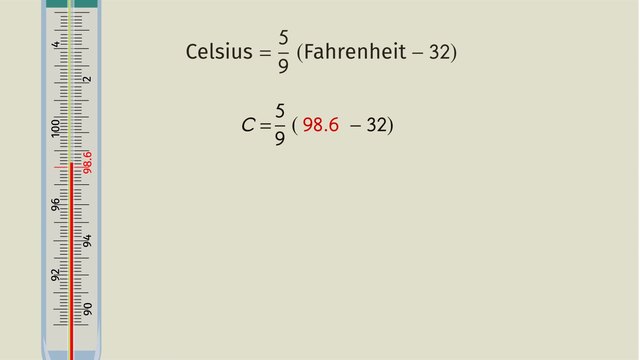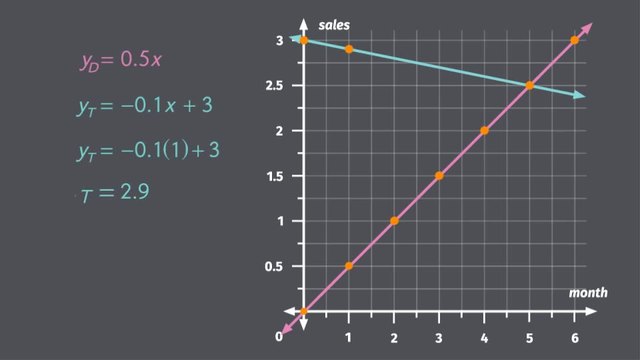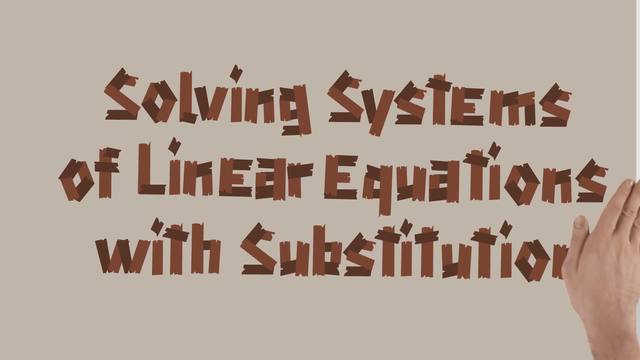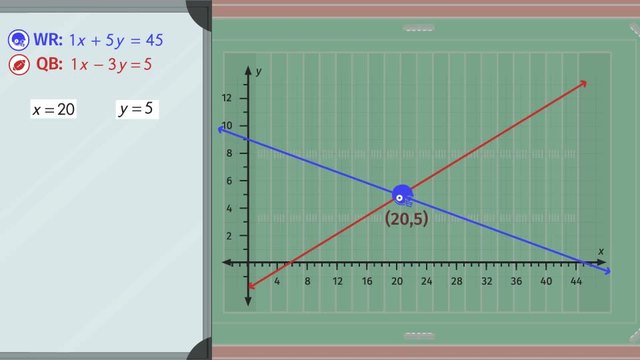Temperature Conversion


Basics on the topic Temperature Conversion
After this lesson, you will be able to convert between Celsius and Fahrenheit.
The lesson begins by teaching you that the formula to convert Fahrenheit to Celsius is C=(5/9)(F-32). It leads you to learn that by isolating the variable F, the formula for Fahrenheit is F=(9C/5)+32. It concludes by offering the use of 2 for 9/5 and 1/2 for 5/9 to easily estimate the temperature.
Learn about temperature conversions by seeing Glen and Nigel settle into their roommate arrangement.
This video includes key concepts, notation, and vocabulary such as the formulas for the conversion of temperature measurements from Celsius to Fahrenheit and vice-versa.
Before watching this video, you should already be familiar with solving linear equations by isolating one variable and solving word problems by replacing unknown variables with given quantities.
After watching this video, you will be prepared to solve real-world situations and problems that involve other measurements with formulas using whole number exponents like area and volume.
Common Core Standard(s) in focus: 6.EE.A.2.C A video intended for math students in the 6th grade Recommended for students who are 11 - 12 years old
Transcript Temperature Conversion
Meet Glen. He wants a roommate and everyone in America has declined. The only one to show interest is, Nigel. Nigel and Glen just need to finalize a few things before Nigel moves in. Glen has drawn up an agreement for the one thing he’s most particular about: temperature. Glen always wants certain temperatures to be the same: the room the shower and most importantly, Glen! Nigel finds all of this a little odd, but signs the agreement anyway. Little do these fast friends know they’ll need to apply everything they know about Temperature Conversion to get along. Glen looks a little under the weather so Nigel helps out by taking his temperature, 98.6?!? Glen’s burning up! The normal body temperature in Celsius is 37 degrees. But he thermometer is in Fahrenheit! When converting Fahrenheit to Celsius, you just have to remember a simple formula: This says that, to get a temperature in Celsius you first have to subtract 32 from the temperature in Fahrenheit and then multiply the result by five-ninths. Let’s plug in Glen’s temperature to see if he’s really sick. Subtracting 32 from Glen's temperature of 98.6, we get 66.6. Then, we multiply by 5, giving us 333 over 9 and dividing gives us 37 degrees. So Glen's temperature is normal, but fearing the worst, Nigel raises the water temperature and changes the room temperature to 23 degrees for his new buddy. Let’s see where Nigel went wrong. In Fahrenheit, 23 degrees is really cold maybe Nigel's still thinking in terms of degrees Celsius. Let's convert this temperature from Celsius to Fahrenheit. When converting from Celsius to Fahrenheit you have to use the opposite formula from before. First, multiply both sides of the equation by the reciprocal of 5 over 9 in order to remove the fraction on the right side of the equation. Then, isolate the 'F' by adding 32 to both sides of the equation. Now we can substitute 23°C in our equation to see how hot or cold it is in the apartment. First, much like before, substitute the temperature in Celsius, 23 degrees, into the equation multiplying 23 by 9 gives us 207 dividing this by 5 gives us 41.4 and finally, adding 32 gives us the temperature in Fahrenheit, 73.4. So, to review when converting Celsius to Fahrenheit. Multiply the the temperature in Celsius by 9 over 5. Then add 32 to the product and to convert Fahrenheit to Celsius first subtract 32 then multiply the result by 5 over 9. However, if you're converting temperature and you just need an estimate you can multiply by 2 when you need to multiply by 9 over 5 and divide by 2 if you need to multiply by 5 over 9. Let's see how Glen and Nigel are getting along. Oh, good. It looks like they’ve cleared up the confusion. But this brain marathon has made Glen sweaty, so he decides to take a shower. Oops...Nigel must have forgotten to change the water temperature back…
Temperature Conversion exercise
-
Rewrite the Fahrenheit equation and set it equal to Celsius.
HintsThe inverse of addition is subtraction.
The reciprocal is also called the Multiplicative Inverse. It's the number we can multiply by in order to get $1$. To get a reciprocal of a number, we change the numerator and denominator.
For example: the reciprocal of $7$ is $\frac{1}{7}$ because $7 \cdot \frac{1}{7}=1$. The reciprocal of $\frac{4}{11}$ is $\frac{11}{4}$ because $\frac{4}{11} \cdot \frac{11}{4} = 1$.
Only like terms can be simplified when adding and subtracting. If they are not like terms, leave it as an expression.
SolutionNigel has to isolate $C$ and since $32$ is being added, Nigel needs to subtract $32$ from both sides of the equation.
- $\begin{array}{rcr} F&=&\frac{9}{5}C+32\\ \color{#669900}{-32} & &\color{#669900}{-32}\\\end{array}$
- Since 32-32=0, they cancel each other out
- Now the equation is written as $F-32=\frac{9}{5}C$
- $\begin{array}{rcr} (F-32) \color{#669900}{\cdot\frac{5}{9}}=\frac{9}{5}C \color{#669900}{\cdot\frac{5}{9}}\\ \end{array}$
- $\frac{5}{9}\cdot \frac{9}{5}=1$ cancel each other out
-
Determine the corresponding unit conversions.
HintsThe Fahrenheit temperature is always a larger number than its equivalent Celsius temperature.
The Fahrenheit and Celsius scales begin at a different number - where $0^{\circ}$ Celsius is freezing, that equivalent temperature in Fahrenheit is $32^{\circ}$.
Recall the formulas:
- $F=\frac{9}{5}C+32$
- $C=\frac{5}{9}(F-32)$
SolutionFirst, decide which formula you are going to use:
$F=\frac{9}{5}C+32$ or $C=\frac{5}{9}(F-32)$
Pick one of the formulas - you do not have to use both. If you really want to use both, you can use the second formula to check your answer!
To convert the temperature of the living room from Fahrenheit to Celsius, use the formula $C=\frac{5}{9}(F-32)$ and plug in $72$ for F.
- $C=\frac{5}{9}(72-32)=\frac{5}{9}(40)=22.2^{\circ}$
- If you want to use the other formula, you will see that the pairs still match:
- $F=\frac{9}{5}(22.2)+32=39.96+32=72^{\circ}$
- $C=\frac{5}{9}(68-32)=\frac{5}{9}(36)=20^{\circ}$
- $C=\frac{5}{9}(110-32)=\frac{5}{9}(78)=43^{\circ}$
- $C=\frac{5}{9}(0-32)=\frac{5}{9}(-32)= -17.7^{\circ}$
- Yes, temperatures can be negative numbers!
- $C=\frac{5}{9}(75-32)=\frac{5}{9}(43)=23.9^{\circ}$
-
Estimate the conversion between Fahrenheit and Celsius.
HintsSince $\frac{9}{5}\approx2$, you can replace $\frac{9}{5}$ with $2$ when you are estimating the conversion from Celsius to Fahrenheit.
Since $\frac{5}{9}\approx\frac{1}{2}$, you can replace $\frac{5}{9}$ with $\frac{1}{2}$ when you are estimating the conversion from Fahrenheit to Celsius.
When converting Celsius to Fahrenheit, you will have to multiply by a value greater than $1$ and add a positive value. This means that the converted Fahrenheit value will always be greater than the Celsius value.
SolutionFor the shower: To estimate the conversion from Celsius to Fahrenheit, Nigel has to multiply $43$ degrees Celsius by $2$, which equals $86$. Then he has to add a value of $32$, which then equals $118°F$.
For the tea: To estimate the conversion from Fahrenheit to Celsius, Nigel will subtract $32$ from $170$, which equals $138$. Then he divides that value by $2$, which results to $69°C$.
-
Rewrite the equation.
HintsTo eliminate a term that is being added, take the inverse operation which is subtraction.
Dividing by a value is the same as multiplying by the reciprocal of that value. For example: multiplying by sides by $\frac{1}{2}$ is the same as dividing by $2$.
If terms do not combine, then write them as an expression. For example, $x+10$ would stay as $x+10$.
SolutionStep $1$: Since Nigel knows that the width of the room is $10$ ft, we first plug in $10$ for $W$.
- $P=2(L+W)$
- $P=2(L+10)$
- $\begin{array}{rcl}P&=&2(L+10)\\\color{#669900}{\div2} & & \color{#669900}{\div2}\\\end{array}$
- $\frac{P}{2}= (L+10)$
- $\begin{array}{rcr} \frac{P}{2}&=& L+10\\ \color{#669900}{-10} & &\color{#669900}{-10}\\ \end{array}$
- $\frac{P}{2}-10=L$
- $L=\frac{P}{2}-10$
-
Given the value of one variable, solve the equation.
HintsPlug in the given value for $b$, then follow order of operations to simplify that side.
Then use the inverse operations to isolate a variable. For example, the inverse of addition is subtraction, and the inverse of multiplication is division.
To solve for $a$, the variable has to be completely isolated with a coefficient of positive $1$.
Solution- First, plug in the given value for $b$ into the given equation.
- Next, follow order of operations: parentheses, multiplication/division, and addition/subtraction. Keep in mind that when you are multiplying/dividing or adding/subtracting, you should work from left to right.
- Simplify until the equation is solved for $a$.
Problem 1
- $2a = 6(b-19)$ where $b= 5$
- $2a = 6(5-19)$
- $2a = 6(-14)$
- $2a= -84$
- Since the coefficient of $a$ is not yet one, we need to divide both sides by $2$, leaving us with:
- $a = -42$
Problem 2
- $\frac{3}{8}b-23=a$ where $b=11$
- $a=\frac{3}{8}(11)-23$
- $a=\frac{33}{8}-23$
- $a=\frac{33}{8}-\frac{184}{8}$
- $a=-\frac{151}{8}$
- $a=\frac{5}{4}(b-7)$ where $b= 0$
- $a=\frac{5}{4}(0-7)$
- $a=\frac{5}{4}(-7)$
- $a=-\frac{35}{4}$
- $a=12b-40$ where $b=6$
- $a=12(6)-40$
- $a= 72-40$
- $a= 32$
- $a+7b=18$ where $b= -9$
- $a+7(-9)=18$
- $a+(-63)=18$
- $a=81$
-
Match the equivalent two-variable equations.
HintsWhen there is an expression being divided by a value, you can multiply the entire expression by that value to eliminate the denominator.
For example:
- $y=\frac{a+6}{3}$
- $3\cdot y=3\cdot \frac{a+6}{3}$
- $3y= a+6$
- $3y-6 = a$
When you have a constant multiplied to an expression inside of parentheses, you can eliminate that constant by dividing both sides of the equation by that constant.
For example:
- $y= 5(x+7)$
- $\frac{y}{5} = \frac{5(x+7)}{5}$
- $\frac{y}{5}= x+7$
- $\frac{y}{5} -7 = x$
In order to completely isolate a variable, the coefficient of the variable must be positive $1$. If it is a negative value, then you have to multiply or divide by $-1$ on both sides of the equation.
For example:
- $7y= -x$
- $-1\cdot 7y=-1\cdot (-x)$
- $-7y= x$
SolutionStarting with $x=3y+7$ and $y=\frac{x-7}{3}$ , we want to isolate $y$, so we need to use reverse order of operations and subtract $7$ from both sides of the equation and simplify.
- $\begin{array}{rcr} x&=&3y+7\\ \color{#669900}{-7} & &\color{#669900}{-7}\\ \end{array}$
- $x-7=3y$
- $\begin{array}{rcr} x-7&=&3y\\ \color{#669900}{\div3} & & \color{#669900}{\div3}\\ \end{array}$
- $\frac{x-7}{3}=y$
- $y=\frac{x-7}{3}$
Starting with $x=\frac{18}{4}y-4$ , we first have to add $4$ to both sides to isolate y.
- $\begin{array}{rcr} x&=&\frac{18}{4}y-4\\ \color{#669900}{+4} & &\color{#669900}{+4}\\ \end{array}$
- $x+4=\frac{18}{4}y$
- $\begin{array}{rcr} (x+4)\color{#669900}{\cdot\frac{4}{18}}=\frac{18}{4}y \color{#669900}{\cdot\frac{4}{18}}\\ \end{array}$
- $\frac{4}{18}(x+4)= y$
- $\frac{4}{18} = \frac{2}{9}$
-------------------------------------------------------------------------------------
To isolate y for the equation $x=3(y+4)$ ,we first have to divide both sides of the equation by $3$ .
- $\begin{array}{rcr }x&=&3(y+4)\\ \color{#669900}{\div3} & & \color{#669900}{\div3}\\ \end{array}$
- $\frac{x}{3}=y+4$
- $\begin{array}{rcr}\frac{x}{3} &=& y+4\\ \color{#669900}{-4} & &\color{#669900}{-4}\\ \end{array}$
- $y=\frac{x}{3}-4$
--------------------------------------------------------------------------
To isolate y for the equation $x=20-5y$ , we first have to subtract both sides of the equation by $20$ .
- $\begin{array}{rcl} x&=&20-5y\\ \color{#669900}{-20} & &\color{#669900}{-20}\\ \end{array}$
- $x-20= -5y$
- $\begin{array}{rcr} x-20&=&-5y\\ \color{#669900}{\div(-5)} & &\color{#669900}{\div(-5)}\\ \end{array}$
- $\frac{x-20}{-5}=y$
- $-\frac{x}{5} + \frac{20}{5}$ = $-\frac{x}{5} + 4$
- $y=-\frac{x}{5} + 4$
To isolate y for the equation $x=\frac{3}{7}(y+3)$ ,we first have to multiply both sides of the equation by the reciprocal of $\frac{3}{7}$ which is $\frac{7}{3}$ .
- $\begin{array}{rcr} x\color{#669900}{\cdot\frac{7}{3}}=\frac{3}{7}(y+3) \color{#669900}{\cdot\frac{7}{3}}\\ \end{array}$
- $\frac{7}{3}x=y+3$
Next, subtract both sides of the equation by $3$ .
- $\begin{array}{rcr}\frac{7}{3}x&=&y+3\\ \color{#669900}{-3} & &\color{#669900}{-3}\\ \end{array}$
- $ \frac{7}{3}x-3=y$
Notice that the $y$ is now isolated. We could leave it like this or we could use the symmetric property of equality and write:
- $y=\frac{7}{3}x-3$
















